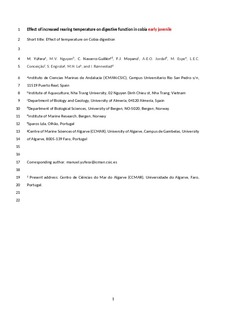| dc.description.abstract | The present study is focused to elucidate the main characteristics of the digestive function of this carnivorous fast-growing fish living at high temperatures. With this aim, we have examined the effects of an increased temperature from 30 to 34 °C on the daily pattern of gastrointestinal pH, enzymatic proteolytic digestive activity and the feed transit time in early juveniles of cobia (Rachycentron canadum), a species living in tropical and subtropical waters with an increasing aquaculture production. Fish were fed two meals a day. Gastric luminal pH was permanently acidic (mean pH values: 2.76–4.74) while the intestinal pH increased from neutral/slightly acidic to slightly alkaline when the digesta was present, with an increasing alkalinity from proximal to distal intestine (mean pH values: 6.05 to 7.69). The temperature did not affect the gastric pH but a slightly higher acidity was induced in the intestine at 34 °C.
Pepsin activity showed a daily rhythm at 30 °C with maximum in the middle of the light period, while at 34 °C some hourly changes coinciding with feed adding without a clear daily trend during the 24-h period were observed. The trypsin activity exhibited a daily rhythm at both temperatures with an increase after morning feeding to reach a maximum several hours later. Average pepsin activity during the daily cycle was slightly higher at 34 °C (6.1 and 7.3 U mg−1 BW at 30 and 34 °C respectively), but values were significantly different only at 8 and 24 h after the morning meal. Similarly, the trypsin activity was significantly affected by the temperature only at 8 and 16 h after the morning meal, but daily activity averages were similar (1.20 and 1.29 U g−1 BW at 30 and 34 °C respectively).
The partial transit rates of the first meal in the stomach for each period inter-samplings were higher during the first 4-h period and decreased progressively along the rest of the 24-h cycle at both temperatures, but no significant differences were detected at 30 °C. In addition, the transit was notably faster at 34 °C particularly during the first 8 h after feeding, with rates between 100 and 65% of total volume displaced (intake or released) during each 4-h period. In the intestine the transit rate was relatively constant and similar at both temperatures during 12 h after feeding. Then the rates remained very low during the following 12 h.
Residence time of the first meal was longer at 30 than at 34 °C, particularly in the stomach (12 h:02 min vs 4 h:54 min respectively). In the intestine the difference was not so large (8 h:18 min vs 6 h:24 min respectively). In a parallel study under same conditions, cobia reared at 30 °C grew faster and showed a more favorable feed conversion ratio than those at elevated temperature (34 °C). The present results indicate that at 34 °C, a subtle increase of proteolytic activity cannot compensate for the faster gut transit rate. Therefore, 30 °C is more appropriate temperature for the early on-growing of cobia because at higher temperatures the digestion efficiency decrease being one of the causes for a lower growth. | nb_NO |
